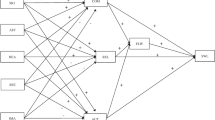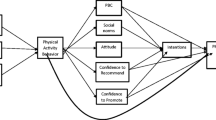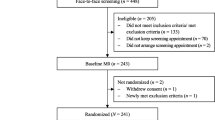Abstract
Exercise-related strategy use and planning were investigated in younger (18-49 years) and older individuals (50-80 years) in orthopedic rehabilitation who were supposed to adhere to a strict exercise regimen. As part of a longitudinal study, N = 368 individuals completed questionnaires assessing the amount of physical activities performed pre-rehabilitation and 6 and 12 months after discharge. In addition, the extent of strategy use (selection, optimization, and compensation) and planning after discharge was assessed. Planning was subdivided into two constructs: action planning (planning when, where, and how to exercise) and coping planning (planning how to exercise in the face of barriers). Two-sample structural equation modeling was used. For both age groups, strategy use improved prediction of exercise goal attainment on top of planning, while strategy use mediated the relationship between coping planning and goal attainment. Interventions fostering strategy use as well as planning might enhance exercise adherence across age groups.
Similar content being viewed by others
References
Arbuckle,J. L., &Wothke, W. (1999).Amos 4.0 user guide. Chicago, IL: Small Waters.
Artistico, D., Cervone, D., & Pezzuti, L. (2003). Perceived self-efficacy and everyday problem solving among young and older adults.Psychology & Aging, 18, 68–79.
Baltes, P. B., Reese, H. W., & Nesselroade, J. R. (1988).Life-span developmental psychology: Introduction to research methods. Hillsdale, NJ, England: Lawrence Erlbaum Associates.
Bandura, A. (1986).Social foundations of thought and action. A social cognitive theory. Englewood Cliffs, NJ, Prentice-Hall.
Bandura, A. (2005). The primacy of self-regulation in health promotion.Applied Psychology: An International Review, 54, 245–254.
Bandura, A., & Locke, E. A. (2003). Negative self-efficacy and goal effects revisited.Journal of Applied Psychology, 88, 87–99.
Baron, R. M., & Kenny, D. A. (1986). The moderator-mediator variable distinction in social psychology research: Conceptual, strategic and statistical considerations.Journal of Personality and Social Psychology, 51, 1173–1182.
Booth, M. L., Macaskill, P., Owen, N., & Oldenburg, B. (1993). Population prevalence and correlates of stages of change in physical activity.Health Education Quarterly, 20, 431–440.
Brandtstädter, J., & Renner, G. (1990). Tenacious goal pursuit and flexible goal adjustment: Explication and age-related analysis of assimilative and accommodative strategies of coping.Psychology & Aging, 5, 58–67.
Byrne, B. M. (2001).Structural equation modeling with Amos: Basic concepts, applications, and programming. Mahwah, NJ: Lawrence Erlbaum Associates.
Clark, D. O. (1999). Physical activity and its correlates among urban primary care patients aged 55 years or older.Journals of Gerontology: Series B: Psychological Sciences & Social Sciences, 54, S41-S48.
Das, J. P., Kar, B. C., & Parrila, R. K. (1996).Cognitive planning: The psychological basis of intelligent behavior. New Delhi, India: Sage.
Diefendorff, J. M., & Lord, R. G. (2003). The volitional and strategic effects of planning on task performance and goal commitment.Human Performance, 16, 365–387.
Freund, A. M., & Baltes, P. B. (2002). Life-management strategies of selection, optimization and compensation: Measurement by self-report and construct validity.Journal of Personality & Social Psychology, 82, 642–662.
Fuchs, R. (1996). Causal models of physical exercise participation: Testing the predictive power of the construct “Pressure to change”.Journal of Applied Social Psychology, 21,1931–1960.
Gignac, M. A. M., Cott, C., & Badley, E. M. (2002). Adaptation to disability: Applying selective optimization with compensation to the behaviors of older adults with osteoarthritis.Psychology & Aging, 17, 520–524.
Gollwitzer, P. M. (1996). The volitional benefits of planning. In P. M. Gollwitzer, & J. A. Bargh (Eds.),The psychology of action: Linking cognition and motivation to behavior (pp. 287–312). New York: Guilford.
Kuhl, J., & Goschke, T. (1994). A theory of action control: Mental subsystems, modes of control, and volitional conflict resolution strategies. In J. Kuhl & J. Beckmann (Eds.),Volition and personality: Action versus state orientation (pp. 93–124). Göttingen: Hogrefe.
Leventhal, H., & Mora, P. A. (2005). Is there a science of the processes underlying health and illness behaviors? A comment on Maes and Karoly.Applied Psychology: An International Review, 54, 255–266.
Leontjev, A. N. (1978).Activity, consciousness, and personality. Englewood Cliffs, NJ: Prentice-Hall.
Lippke, S., Ziegelmann, J. P., & Schwarzer, R.(2004). Behavioral intentions and action plans promote physical exercise: A longitudinal study with orthopedic rehabilitation patients.Journal of Sport & Exercise Psychology, 26, 470–483.
Luszczynska, A., & Sutton, S. (2006). Physical activity after cardiac rehabilitation: The evidence that different types of self-efficacy are important in maintainers and relapsers.Rehabilitation Psychology, 51, 314–321.
Miller, D. J., Freedson, P. S., & Kline, G. M. (1994). Comparison of activity levels using the Caltrac accelerometer and five questionnaires.Medicine and Science in Sports and Exercise, 26, 376–382.
Netz, Y., & Raviv, S. (2004). Age differences inmotivational orientation toward physical activity: An application of social-cognitive theory.Journal of Psychology: Interdisciplinary & Applied, 138, 35–48.
Prenda, K. M., & Lachman, M. E. (2001). Planning for the future: A life management strategy for increasing control and life satisfaction in adulthood.Psychology & Aging, 16, 206–216.
Prohaska, T. R., Leventhal, E. A., Leventhal, H., & Keller, M. L. (1985). Health practices and illness cognition in young, middle aged, and elderly adults.Journal of Gerontology, 40, 569–578.
Renner, B., Knoll, N., & Schwarzer, R. (2000). Age and body weight make a difference in optimistic health beliefs and nutrition behaviors.International Journal of Behavioral Medicine, 7, 143–159.
Scholz, U., Sniehotta, F. F., & Schwarzer, R. (2005). Predicting physical exercise in cardiac rehabilitation: The role of phase-specific self-efficacy beliefs.Journal of Sport & Exercise Psychology, 27, 135–151.
Schwarzer, R. (1992). Self-efficacy in the adoption and maintenance of health behaviors: Theoretical approaches and a new model. In R. Schwarzer (Ed.)Self-efficacy: Thought control of action (pp. 217–243). Washington, DC: Hemisphere.
Schwarzer, R., & Renner, B. (2000). Social-cognitive predictors of health behavior: Action self-efficacy and coping self-efficacy.Health Psychology, 19, 487–495.
Smith, J. (1999). Anticipating future life goals and managing personal development. In J. Brandstäfer &R. M. Lerner (Eds.), Action & self-development: Theory and research through the life span (pp. 223–255). Thousand Oaks: Sage.
Sniehotta, F. F., Scholz, U., & Schwarzer, R. (2005). Bridging the intention-behaviour gap: Planning, self-efficacy, and action control in the adoption and maintenance of physical exercise.Psychology and Health, 20, 143–160.
Sniehotta, F. F., Schwarzer, R., Scholz, U., & Schüz, B. (2005). Action plans and coping plans for long-term lifestyle change: Theory and assessment.European Journal of Social Psychology, 35, 565–576.
Sobel, M. E. (1982). Asymptotic intervals for indirect effects in structural equations models. In S. Leinhart (Ed.),Sociological methodology 1982 (pp.290–312). San Francisco: Jossey-Bass.
Sonnentag, S. (1996). Planning and knowledge about strategies: Their relationship to work characteristics in software design.Behaviour & Information Technology, 15, 213–225.
Ware, J. Jr., Kosinski, M., & Keller, S. D. (1996). A 12-Item Short-Form Health Survey: construction of scales and preliminary tests ofreliability and validity.Medical Care, 34, 220–233.
Weinstein, N. D. (1987). Unrealistic optimism about susceptibility to health problems: Conclusions from a community-wide sample.Journal of Behavioral Medicine, 10, 481–500.
Ziegelmann, J. P., Lippke, S., & Schwarzer, R. (2006a). Adoption and maintenance of physical activity: Planning interventions in young, middle-aged, and older adults.Psychology & Health, 21, 145–163.
Ziegelmann, J. P., & Lippke, S. (in press). Use of Selection, Optimization, and Compensation strategies in health self-regulation: Interplay with resources and successful development.Journal of Aging and Health.
Ziegelmann, J. P., Lippke, S., & Schwarzer, R. (2006b). Subjective residual life expectancy in health self-regulation.Journals of Gerontology: Psychological Sciences, 61B, 195–201.
Ziegelmann, J. P., Luszczynska, A., Lippke, S., & Schwarzer, R. (2007). Are goal intentions or implementation intentions better predictors of health behavior? A longitudinal study in orthopedic rehabilitation.Rehabilitation Psychology, 52, 97–102.
Author information
Authors and Affiliations
Corresponding author
Rights and permissions
About this article
Cite this article
Ziegelmann, J.P., Lippke, S. Planning and strategy use in health behavior change: a life span view. Int. J. Behav. Med. 14, 30–39 (2007). https://doi.org/10.1007/BF02999225
Issue Date:
DOI: https://doi.org/10.1007/BF02999225




